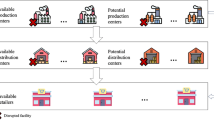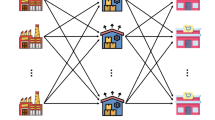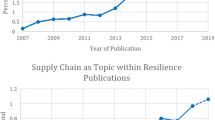Abstract
The 2019 coronavirus disease (COVID-19) epidemic has caused serious disruptions in food supply networks. Based on the case of the remerging epidemic in China, this paper aims to investigate food supply network disruption and its mitigation from technical and structural perspectives. To solve the optimal policy choice problem that how to improve mitigation capability of food supply networks by using traceability technology and adjusting network structure, the occurrence mechanism of food supply network disruptions is revealed through a case study of the remerging COVID-19 outbreak in Beijing’s Xinfadi market. Five typical traceability solutions are proposed to mitigate network disruptions and their technical attributes are analyzed to establish disruption mitigation models. The structure of food supply networks is also controlled to mitigate disruptions. The structural attributes of three fundamental networks are extracted to adjust the network connections pattern in disruption mitigation models. Next, simulation experiments involving the disruption mitigation models are carried out to explore the independent and joint effects of traceability technology and network structure on mitigation capability. The findings suggest that accuracy makes a more positive effect on the mitigation capability of food supply networks than timeliness due to the various technical compositions behind them; the difference between these effects determines the choice decision of supply networks on traceability solution types. Likewise, betweenness centralization makes a positive effect but degree centralization makes a negative effect on mitigation capability because intermediary firms and focal firms in food supply networks have different behavior characteristics; these effects are both regulated by supply network types and exhibit different sensitivities. As for the joint effect of technical and structural attributes on mitigation capability, the joint effect of accuracy and betweenness centralization is bigger than the independent effects but smaller than their sum; the joint effect of timeliness and betweenness centralization depends on networks type; while the positive effect of accuracy or timeliness on mitigation capability is greater than the negative effect of degree centralization; theses joint effects are caused by the complicated interactive effects between technical composition and behaviors of intermediary firms or focal firms. These findings contribute to disruption management and decision-making theories and practices.







Similar content being viewed by others
Explore related subjects
Discover the latest articles, news and stories from top researchers in related subjects.References
Anzola D, Barbrook-Johnson P, Cano JI (2017) Self-organization and social science. Comput Math Organ Theory 23(2):221–257
Buchta C, Meyer D, Pfister A, Mild A, Taudes A (2003) Technological efficiency and organizational inertia: a model of the emergence of disruption. Comput Math Organ Theory 9(2):127–146
Bugert N, Lasch R (2018) Effectiveness of responsive pricing in the face of supply chain disruptions. Comput Ind Eng 124:304–315
Chapman P, Christopher M, Jüttner U, Peck H, Wilding R (2002) Identifying and managing supply chain vulnerability. Logist Transp Focus 4(4):59–70
Chebolu-Subramanian V, Gaukler GM (2015) Product contamination in a multi-stage food supply chain. Eur J Oper Res 244(1):164–175
Chen Y, Yu X (2018) Does the centralized slaughtering policy create market power for pork industry in China? China Econ Rev 50:59–71
Chongwatpol J, Sharda R (2013) RFID-enabled track and traceability in job-shop scheduling environment. Eur J Oper Res 227(3):453–463
Cui J (2020) Disinfection and sterilization in Jingshen seafood market. Beijing Youth Daily, p A01
Dandage K, Badia-Melis R, Ruiz-García L (2017) Indian perspective in food traceability: a review. Food Control 71:217–227
Ding L, Yuan H, Hu B (2021) Adopt or not: manufacturers’ RFID decisions for gray marketing in a competitive environment. Comput Ind Eng 151:106957
El Baz J, Ruel S (2020) Can supply chain risk management practices mitigate the disruption impacts on supply chains’ resilience and robustness? Evidence from an empirical survey in a COVID-19 outbreak era. Int J Prod Econom 233:107972
Gautam R, Singh A, Karthik K, Pandey S, Scrimgeour F, Tiwari MK (2017) Traceability using RFID and its formulation for a kiwifruit supply chain. Comput Ind Eng 103:46–58
Han Y, Yang L, Jia K, Li J, Feng S, Chen W et al (2021) Spatial distribution characteristics of the COVID-19 pandemic in Beijing and its relationship with environmental factors. Sci Total Environ 761:144257
Jia X, Sun L (2020) Jingshen seafood wholesale market is no longer open to individual consumers. Beijing Daily, pp A03
Kim Y, Chen YS, Linderman K (2015) Supply network disruption and resilience: a network structural perspective. J Oper Manage 33:43–59
Kumar M, Basu P, Avittathur B (2018) Pricing and sourcing strategies for competing retailers in supply chains under disruption risk. Eur J Oper Res 265(2):533–543
Li M, Shen L, Huang GQ (2019) Blockchain-enabled workflow operating system for logistics resources sharing in E-commerce logistics real estate service. Comput Ind Eng 135:950–969
Lin X, Zhang D, Wang X, Huang Y, Du Z, Zou Y et al (2017) Attitudes of consumers and live-poultry workers to central slaughtering in controlling H7N9: a cross-sectional study. BMC Public Health 17(1):517
Lu X, Horn AL, Su J, Jiang J (2019) A universal measure for network traceability. Omega 87:191–204
MacKenzie CA, Apte A (2017) Modeling disruption in a fresh produce supply chain. Int J Logist Manage 28(2):656–679
Mai N, Bogason SG, Arason S, Árnason SV, Matthíasson TG (2010) Benefits of traceability in fish supply chains—case studies. Br Food J 112:976
Mejjaouli S, Babiceanu RF (2015) RFID-wireless sensor networks integration: decision models and optimization of logistics systems operations. J Manuf Syst 35:234–245
Mofan C, Changta C (2017) Analysis and comparison of operational efficiency of rural E-commerce and farmer-supermarket docking modes. Logist Technol 3:12
Mohammadzadeh N, Zegordi SH (2016) Coordination in a triple sourcing supply chain using a cooperative mechanism under disruption. Comput Ind Eng 101:194–215
Nair A, Vidal JM (2011) Supply network topology and robustness against disruptions—an investigation using multi-agent model. Int J Prod Res 49(5):1391–1404
Niknejad A, Petrovic D (2016) A fuzzy dynamic inoperability input–output model for strategic risk management in global production networks. Int J Prod Econ 179:44–58
Óskarsdóttir K, Oddsson GV (2019) Towards a decision support framework for technologies used in cold supply chain traceability. J Food Eng 240:153–159
Piramuthu S, Farahani P, Grunow M (2013) RFID-generated traceability for contaminated product recall in perishable food supply networks. Eur J Oper Res 225(2):253–262
Rivkin JW, Siggelkow N (2007) Patterned interactions in complex systems: implications for exploration. Manage Sci 53(7):1068–1085
Simon HA (1991) The architecture of complexity. In: Klir GJ (ed) Facets of systems science. Springer, Boston, pp 457–476
Skilton PF, Robinson JL (2009) Traceability and normal accident theory: how does supply network complexity influence the traceability of adverse events? J Supply Chain Manage 45(3):40–53
Storøy J, Thakur M, Olsen P (2013) The TraceFood framework—principles and guidelines for implementing traceability in food value chains. J Food Eng 115(1):41–48
Sturgeon TJ (2002) Modular production networks: a new American model of industrial organization. Ind Corp Change 11(3):451–496
Sun Y (2020) Xinfadi market fully recovered. Beijing Daily, pp A09
Wattanakul S, Henry S, Bentaha ML, Reeveerakul N, Ouzrout Y (2018) Improvement of the containerize performance based on the unitary traceability of smart logistics units
Wen Z, Hu S, De Clercq D, Beck MB, Zhang H, Zhang H et al (2018) Design, implementation, and evaluation of an Internet of Things (IoT) network system for restaurant food waste management. Waste Manage 73:26–38
Wu Z, Wang Q, Zhao J, Yang P, McGoogan JM, Feng Z, Huang C (2020) Time course of a second outbreak of COVID-19 in Beijing, China, June–July 2020. JAMA 324(14):1458–1459
Xu S, Zhang X, Feng L, Yang W (2020) Disruption risks in supply chain management: a literature review based on bibliometric analysis. Int J Prod Res 58(11):3508–3526
Zhang J, Liu L, Mu W, Moga LM, Zhang X (2009) Development of temperature-managed traceability system for frozen and chilled food during storage and transportation. J Food Agric Environ 7(3&4):28–31
Zhou P, Shi ZL (2021) SARS-CoV-2 spillover events. Science 371(6525):120–122
Acknowledgements
This research is supported by the National Natural Science Foundation of China (71971093, 71810107003, 72132001) and National Social Science Foundation of China(20&ZD126).
Author information
Authors and Affiliations
Corresponding author
Additional information
Publisher's Note
Springer Nature remains neutral with regard to jurisdictional claims in published maps and institutional affiliations.
Appendix
Appendix
The average degree is the average number of arcs for all nodes in a network. The metric reflects the complexity of a network as they focus on the number of interactions in the network.
Before giving the notation of betweenness centralization, we must introduce node-level betweenness centrality \(C_{B} \left( {n_{i} } \right)\). This item calculates how often the node \(n_{i}\) lies on the shortest path in a network and is thus defined as:
where \(g_{k,h} \left( {n_{i} } \right)\) is the number of shortest paths between the source and sink nodes and through the node \(n_{i}\), and \(g_{k,h}\) is the total number of shortest paths from the source node to the sink node in a network.
Betweenness centralization represents the betweenness centrality from an entire network perspective. This metric is determined by calculating the average frequency of each node lying on the shortest path in a network:
Similarly, degree centralization is based on node-level degree centrality \(C_{D} \left( {n_{i} } \right)\).
where \(d\left( {n_{i} } \right)\) is the number of neighboring nodes of the node \(n_{i}\).
While degree centralization describes the degree centrality of an entire network, which is denoted as:
where \(C_{D} \left( {n^{*} } \right)\) is the maximum value of \(C_{D} \left( {n_{i} } \right)\).
Rights and permissions
Springer Nature or its licensor holds exclusive rights to this article under a publishing agreement with the author(s) or other rightsholder(s); author self-archiving of the accepted manuscript version of this article is solely governed by the terms of such publishing agreement and applicable law.
About this article
Cite this article
Wang, L., Hu, B., Feng, Y. et al. Food supply network disruption and mitigation: an integrated perspective of traceability technology and network structure. Comput Math Organ Theory 28, 352–389 (2022). https://doi.org/10.1007/s10588-022-09366-z
Accepted:
Published:
Issue Date:
DOI: https://doi.org/10.1007/s10588-022-09366-z




